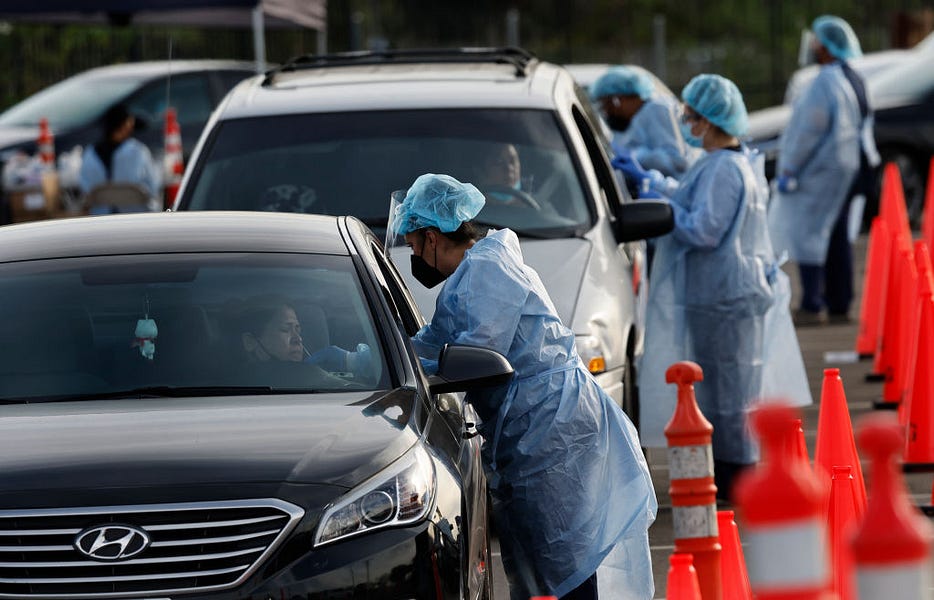Happy Monday! Fun fact of the day: Aaron Rodgers and Rex Grossman have started the same number of Super Bowls at quarterback.
And we hope Sens. Susan Collins and Joe Manchin huddle this week to discuss a bipartisan path forward on updating the NFL’s archaic overtime rules. How could last night’s game end without Josh Allen and the Bills getting one more chance?!
Quick Hits: Today’s Top Stories
-
U.K. Foreign Secretary Liz Truss issued an unusual press release Saturday night declaring the U.K. has intelligence indicating “the Russian Government is looking to install a pro-Russian leader in Kyiv as it considers whether to invade and occupy Ukraine.” Russia’s Foreign Ministry accused the U.K. of “spreading nonsense,” but U.S. officials have reached similar conclusions in recent weeks.
-
The State Department on Sunday ordered family members of U.S. Embassy officials in Kyiv to leave Ukraine due to the “threat of Russian military action,” adding that nonessential embassy staff are allowed to leave as well. The State Department also updated its travel advisory for Ukraine to Level 4, encouraging all U.S. citizens in Ukraine to “consider departing now.”
-
Citing the country’s long-standing, “very clear stance on weapons exports,” German Chancellor Olaf Scholz told reporters on Friday Germany will likely not join the United States and United Kingdom in sending arms to Ukraine ahead of an increasingly likely Russian invasion. It also blocked NATO ally Estonia from sending German-origin weapons to Kyiv as well.
-
A Centers for Disease Control study released Friday found that, from mid-December when Omicron became the dominant variant through January 5, 2022, individuals two weeks past their third vaccine dose were 90 percent less likely to be hospitalized for COVID-19 than unvaccinated individuals. Those more than 180 days past their second dose but not boosted were 57 percent less likely to be hospitalized for COVID-19 than the unvaccinated.
-
U.S. District Judge Jeffrey Brown blocked the Biden administration’s vaccine requirement for federal employees, writing that the president’s authority is not “broad” enough to mandate that “all federal employees consent to vaccination against COVID-19 or lose their jobs.” The White House said 98 percent of federal employees are already in compliance with the mandate, and the Justice Department plans to appeal the ruling.
-
The U.S. Office of Personnel Management announced Friday it is directing federal agencies to raise the minimum wage for all government employees to $15 an hour by January 30. The move—which comes after an executive order from President Biden—will affect about 70,000 workers, primarily from the Departments of Agriculture, Defense, and Veterans Affairs.
-
A Saudi-led military coalition launched airstrikes on Friday that targeted a prison in northern Yemen and killed at least 87 people. The strikes—which also shut down internet access in most of the country—came days after Iranian-backed Houthi rebels launched a drone attack in Abu Dhabi.
-
The National Archives has officially transferred to the January 6 Select Committee the more than 700 pages of documents that former President Donald Trump sought to block, including a never-issued executive order that would have directed the Defense Department to seize voting machines. Rep. Bennie Thompson said yesterday the committee had already spoken with former Attorney General Bill Barr about the documents.
-
Intel announced Friday it plans to invest tens of billions of dollars to build two semiconductor manufacturing plants in Ohio. The “fabs” will be Intel’s first new manufacturing sites in 40 years, and the company says they will create 3,000 Intel jobs and 7,000 construction jobs—and be at least partially operational in 2025.
Is Omicron Peaking?
When we last wrote to you about the Omicron variant a few weeks ago, an epidemiological consensus had emerged: The new variant was much more transmissible than Delta, better able to evade existing immunity (both vaccine and natural), and less likely to cause severe disease. The severity of this winter’s surge would be determined by whether or not the effects of the former two outweighed those of the latter.
Thus far, it’s played out more or less how you’d expect given those inputs. Daily case counts—and test positivity—have been off the charts, with the average number of confirmed infections this winter peaking more than three times higher than the worst point in last winter’s surge. Had deaths increased at the same rate, we’d be staring down several weeks of more than 11,000 COVID-19 fatalities every day. Thankfully, they haven’t: We’re currently averaging just under 2,000 per day, which is about where we were in mid-September and an approximately 42 percent decline from last January’s deadliest period. And evidence that large portions of the country are through the worst of it continues to mount.
“It’s pretty clear most places are about to peak, are peaking, or are now starting to decline,” said Dr. Isaac Bogoch, a clinical epidemiologist and infectious disease expert at the University of Toronto. Omicron didn’t reach all 50 states at the same time, but those it hit first have seen infection rates plummet. New York was averaging about 75,000 new cases per day on January 11. Yesterday, less than two weeks later, that number was below 28,000. New Jersey: 31,000 to 10,500. Washington, D.C.: 2,300 to 760.
Most states are not yet that far down the other side of their curve—Tennessee, for example, appears to have just hit its peak on Friday or Saturday, and cases are still rising in Montana—but all signs point to Omicron burning through the United States as quickly as it did other countries.
“We’ve seen this pattern now in several countries—first in South Africa, then in the U.K., now New York, New Jersey, Connecticut—[of] explosive spread, very high peaks, and then fairly rapid decline,” said Dr. Chris Beyrer, an infectious disease epidemiologist at Johns Hopkins’ Bloomberg School of Public Health. “If that continues to hold true, it’s going to take a while for the places that had Omicron later to get through this wave. But I think by mid- to late-February—barring another variant—things are going to look, really, a lot better.”
That caveat—“barring another variant”—really puts a damper on the otherwise great news that we could be past this wave in a few more weeks. But having prematurely spiked the football multiple times over the past two years, some humility about the direction of the pandemic is probably in order. “You don’t stand on the beaches of Florida after a hurricane has passed by and say, ‘Well, that’s it! There’s no more hurricanes!’” Bogoch told The Dispatch. “And the same is true with variants of concern.”
The question is not whether the virus will continue to mutate—it almost assuredly will, that’s what viruses do—but whether future mutations render it an increased or decreased threat. Delta, for example, was both more infectious and more severe than its predecessors, while Omicron is only the former. The pathogen will ultimately become endemic like the flu and the common cold, but future variants—Pi, Rho, Sigma, Kappa Alpha Theta, etc.—could still take us on a detour en route to that final destination.
A preprint Africa Health Research Institute (AHRI) study from a few weeks ago, however, provides reason for hope. Although prior infection with the Delta variant provided little protection against Omicron, the AHRI researchers found that the opposite did not appear to be true: Those infected with the Omicron variant generated antibodies that were effective against Delta, too.
The million-dollar question, per Bogoch, is whether vaccines (plus boosters) and millions of Omicron infections will provide a strong enough line of defense against whatever new variant comes along. “Can we build up enough community-level immunity such that, when the next wave rolls through town, it just doesn’t disrupt us as significantly as prior waves have?” he said. “There will be more variants. It’s just, to what extent will they be disruptive—hopefully less and less and less.”
For Beyrer, the past few months have served as an important reminder of the importance of distributing vaccines globally. “The way to tamp down these new variants, at least partly, is going to have to be to ensure that everybody with immunocompromise is vaccinated and boosted,” he said, noting the Omicron variant likely emerged after accumulating up to a year’s worth of mutations inside a person whose immune system was incapable of containing it. “We’re just not there. I mean, [in] South Africa, one in five adults is living with HIV. Just a huge proportion of the population is immunocompromised.”
But before we worry about the next variant wave, we still have to muddle through several difficult weeks of our current one. “You have to remember, you have to crawl down the other side of the map. And it’s a long way up, which also means it’s a long way down,” Bogoch said. “[It’s] better than being at 48 percent, but it’s only 51 percent.”
The Last March Against Roe?
Despite the freezing cold temperatures, thousands upon thousands of anti-abortion advocates assembled in Washington, D.C. on Friday to participate in the annual March for Life. Andrew was there, and, in a piece for the site, tells the story of a movement on the precipice of achieving one of its most long-standing goals.
This summer, the Supreme Court intends to reach a decision on Dobbs v. Jackson Women’s Health, the most direct challenge to Roe v. Wade since Casey v. Planned Parenthood in 1992.
“It amazes me—I never thought the day would come when Roe might actually be overturned,” former Rep. Dan Lipinski, a pro-life Democrat who served in Congress from 2005 until 2021 and who spoke at the rally Friday, told The Dispatch. “It just seemed for decades that the Supreme Court justices that were appointed and confirmed, that we thought things were going to change and that Roe might be overturned—[but then] we went through Casey in the early ‘90s. So I never thought we’d get to this point.”
So, despite obstacles, despite the January cold, here they were, marching. The advocacy group Students for Life, which for years has handed out “We Are the Pro-Life Generation” signs at events like this, had a new slogan on offer: “We are the Post-Roe Generation.” Another entity, the lay Catholic American Society for the Defense of Tradition, Family and Property, had volunteers stationed around the Mall, handing out pamphlets to the assembling throng: “The Day After: What Is Our Dream for a Post-Roe America?”
March attendees tend to be less outwardly partisan than the D.C. press expects, and Friday was no different.
It was easy enough, during the Trump years, to write the thing off as the president’s closest-to-home mega-rally—but that always obscured just how little many of the marchers seem to care about politics in general. These aren’t members of the activist class, though the March does attract a patina of aspiring thinkfluencers and congressional hopefuls. Sometimes there are weirdos of a darker sort.
Mostly, though, they’re high schoolers, college students, church groups, Knights of Columbus. At the rally before the March, they clap and cheer politely through a few politicians’ speeches and boo at the appropriate times when the talk turns to the Biden administration’s support for abortion rights—but they really get jazzed for the last speaker, a genuine celebrity: the vaguely Jon-Hammish Fr. Michael Schmitz, a Catholic priest and YouTuber who hosts the popular podcast Bible in a Year.
It’s almost funny, watching a crowd like this bounce off the ordinary trappings of Mall activity—street-sellers loaded for bear with LET’S GO BRANDON hats and other assorted GOP lifestyle swag, but who didn’t do much business. You could pick the occasional MAGA hat out of the crowd, but they were surprisingly rare—no larger a contingent than the few megaphone-wielding street preachers who always turn out for the March, apparently on the theory that they won’t get a better opportunity to yell at such a large concentration of Catholics at once.
Does the pro-life community have an idea of what a post-Roe future looks like?
Some marchers, leery of raising their own expectations, said that’s a bridge to be crossed when we come to it. Others made it clear they realize that, although Roe has been the primary target of the pro-life movement for nearly half a century, its dissolution doesn’t mean the movement’s war is won.
“My feeling is, you’ve got to have a plan,” former Sen. Rick Santorum, who attended the rally but did not speak, told The Dispatch. “I mean, the other side’s already passing laws in some of these blue states that are actually worse than Roe v. Wade. They’re actually constraining the pro-life movement and making abortion even more available than it would be. And seeing this side of the Biden administration that may be coming down the road—getting rid of conscience clause protections, mandating hospitals to perform abortions. These are the kinds of things that we’re gonna be dealing with in these blue states—it’s going to be great in some states, but it’s not going to be in others, and we’re gonna have to battle.”
“To me, I don’t think we march here anymore,” Santorum added. “I think we go to the state capitals and focus where the fight is.”
Nor, some pointed out, will the fight be only legislative.
“No matter what the laws say … even if they make it illegal, there’s always gonna be people who still want to access it,” said Avery May, a young rainbow-haired activist with Progressive Anti-Abortion Uprising. “It’s not going to be unthinkable for a very long time. It’s going to take a long time for our culture to actually catch up.”
Worth Your Time
-
Ross Douthat’s latest column focuses on what he sees as the realities of the Russia-Ukraine situation: American overcommitment during the Cold War has left the United States’ with few good options. “Given those difficulties, the Biden administration’s wavering course has been understandable, even if the president’s recent news conference was too honest by several orders of magnitude,” he writes. “The United States cannot do nothing if Russia invades Ukraine; we also would be insane to join the war on Ukraine’s side. So the White House’s quest for the right in-between response, some balance of sanctions and arms shipments, looks groping and uncertain for good reason: There’s simply no perfect answer here, only a least-bad balancing of options.”
-
In a piece for National Review, Nate Hochman (a former Dispatch intern, if you’re keeping score!) details the growing divide between the Chamber of Commerce and Republican Party as the latter trends in an increasingly populist direction. “The business wing of the GOP has often enjoyed significant influence over the party’s political priorities,” he writes. “But as economic populism (especially on trade and antitrust), culture-war priorities (such as critical race theory and transgenderism), and immigration become more prominent as issues in the party, its relationship to traditional allies in the business community has weakened.”
Presented Without Comment
Also Presented Without Comment
Toeing the Company Line
-
Former Democratic Sen. Heidi Heitkamp of North Dakota joined Sarah and Steve on Friday’s Dispatch Podcast for a conversation about President Biden’s first year, the legislative filibuster, and the 2022 midterms.
-
Build Back Better is the social spending package that refuses to die. In Friday’s Uphill (), Haley takes a look at Democratic efforts to revive the bill, and what concessions would need to be made to satisfy Sen. Joe Manchin. “The package won’t satisfy every stakeholder,” she writes. “Now comes the difficult task of identifying which policies to chop.”
-
In a free-flowing G-File, Jonah discusses the importance of prioritizing local problem solving. “The closer you are to a problem, the more likely it is you’ll have a greater grasp of what the real solutions are,” he writes. “The further you are from a problem, the more you rely on abstraction and speculation about how to fix it.” Which brings him to the makers of … M&M’s candy … updating their branding to “increase the sense of belonging for 10 million people around the world.”
-
David’s latest French Press seeks to forge a path forward amid the cults of ideology and personality that are ripping families and communities apart. “We can and should find purpose and meaning in our discontent, in our sense that we don’t truly “fit” with either of America’s most aggressive political and cultural factions,” he writes.
-
In a piece for the site over the weekend, Sarah took a look at what went wrong with NPR’s reporting on masking at the Supreme Court: “Readers are more likely to engage with a story in which they aren’t invited to think too carefully about the motivations or credibility of the sources in question, sources have an incentive to stay anonymous rather than have their credibility questioned, and therefore, reporters have the unfortunate incentive to keep their sources anonymous because it counterintuitively lends credibility to their story.”
Let Us Know
Have you ever attended an issue-based (not candidate-based) political rally, like the March for Life or a racial justice protest? If so, what was the issue that motivated you to get out there? And did you learn anything from the experience?
Reporting by Declan Garvey (@declanpgarvey), Andrew Egger (@EggerDC), Charlotte Lawson (@lawsonreports), Audrey Fahlberg (@AudreyFahlberg), Ryan Brown (@RyanP_Brown), Harvest Prude (@HarvestPrude), and Steve Hayes (@stephenfhayes).







Please note that we at The Dispatch hold ourselves, our work, and our commenters to a higher standard than other places on the internet. We welcome comments that foster genuine debate or discussion—including comments critical of us or our work—but responses that include ad hominem attacks on fellow Dispatch members or are intended to stoke fear and anger may be moderated.
With your membership, you only have the ability to comment on The Morning Dispatch articles. Consider upgrading to join the conversation everywhere.